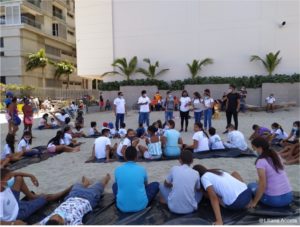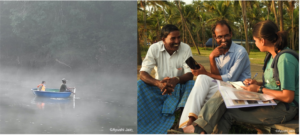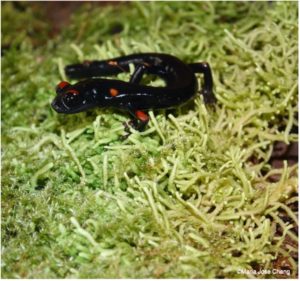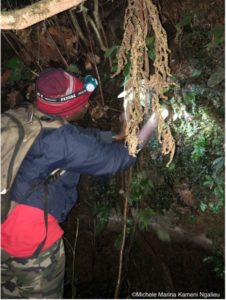Thousands of people around the world work in conservation, inspiring the next generation of conservationists via documentaries, news outlets and social media. Every individual is playing their specific part, like a puzzle piece in a massive and complex jigsaw. The experience of protecting vulnerable species will inevitably differ across countries, habitats, generations and genders – various schedules, motivations, challenges, and inspiring stories!
We recently spoke to some of our EDGE Fellows about what life is like as a conservationist for endangered species.
What is your average day like?
María José – Nimble long-limbed salamander – Guatemala – c.2021-2023
“Right now, since we are in kind of a lockdown in Guatemala, I just wake up do, some exercise, then I start working on the computer and that’s actually my daily routine. Last week I went to the field, so it was awesome. It was a nice breeze of air I really needed.”
Marina – Four EDGE frogs – Cameroon, Africa – c.2020-2022
“It’s different! Sometimes doing fieldwork, sometimes working in the laboratory, sometimes staying home. It depends on the period of the month, but in general when I’m not in the field I’m in the lab. I’m doing a PhD too.”
Rajkumar – Galaxy frog – Kerala, India – c.2019-2021
“I’m doing a PhD, so most of my time I’m spending on my thesis since I’m in lockdown. Other times we are just planning for online and social media platforms, using conservation activities to promote the species, so making cartoons and posters.”
Ayushi spends most of her days in the field in Kerala, India, looking for the Cantor’s giant softshell turtle. Her schedule relies mostly on that of the local community members.
Luan – Botsford’s leaf-litter frog – Vietnam – c.2018-2020
“I come to [the] office and work with people every day and then because I live quite close to some National Parks, we often go there. We can do photography and look for animals there. There is not really a lot of fieldwork at the moment – I spent three weeks in March to survey in southern Vietnam, not in my EDGE project site but for my organisation work related to amphibians, reptiles and turtles.”
How has the outbreak of Covid-19 impacted your fellowship?
María José – Nimble long-limbed salamander – Guatemala – c.2021-2023
“I’m really worried because I have a strong social part of my project that’s working with a community from Quiché. I was planning to start with that work this year, but I don’t know if that’s going to be responsible because I’m not only putting myself at risk but I’m also putting their community people at risk. With the field campaigns, I don’t think it’s going to be a problem, because in Guatemala there’s not strict lockdown, so I can go to the field or places that I’m not going to have that much human contact.”
Marina – Four EDGE frogs – Cameroon, Africa – c.2020-2022
“When you come in the village, they always think that because you are coming from the town you have covid, so people are afraid to talk with you. Even in the town, people are not confident with it. But normally everything is going well so I am happy for that. I’m not late in my timetable so it is ok.”
Rajkumar – Galaxy frog – Kerala, India – c.2019-2021
“Because of the pandemic, it is going in a slower pace. The forest department staff are a little scared as we are coming from urban city places, and we are going to some remote areas so there is a high change we are transmitting the disease to the local community. We don’t know exactly how their immunity is against covid, so they’re not really happy to encourage field visits.”

Sandeep – Purple frog – Kerala, India – c.2017-2019
“If there were no such issues, this is the time when we’re out in the field looking for our species. So, unfortunately, we miss their breeding and many of the work that we had planned for this year because of the lockdown. Unfortunate for the project but fortunate for the animals, because the animals managed to get away from roadkill and human induced pressures. For them, these two years were for successful breeding.”
Do you have a favourite story from fieldwork?
Marina – Four EDGE frogs – Cameroon, Africa – c.2020-2022
“I have many stories. I still remember when I went to the tree for the first time. I was so excited to find at least one of my species, and then when we reached the first plot, I met nothing. It was like, ‘am I sure by the end of this project I will be able to find even one species?’ Then we found a lot of individuals of an endemic species – not the EDGE species but I started being motivated about sampling, and then the next day we went to the tree and then I found my species, but I didn’t know that it was my species! Normally the colour is brown, but this species was like black, but we are working at night. My field guide said, ‘Marina you’ve found the first individual of your species!’ so I was so excited, so happy … it was so amazing!”
Rajkumar – Galaxy frog – Kerala, India – c.2019-2021
“I would say the first fieldwork maybe. After the EDGE tools course, I came back to India and in May I went for my first fieldwork. Since the galaxy frog is really rare, I expected that I would get to see one individual in a couple of months. I went to one of the main locations that they know already, which is a monthly data collection point, it’s called Marayoor, and I found two individuals. As the probability of getting one individual is really hard, I never expected that I could get it in my first field visit, so that was really the moment for my project.”
These two aren’t the only ones! María José also said her favourite field story was the first time she found her EDGE species – the Nimble long-limbed salamander – in Guatemala. From the first time she read its description, she said ‘I really want to see this salamander because it’s really, really beautiful!’. With no more than ten records of this species, she knew it would be hard to see. On a field trip with a friend to Quiché, who said the elevation was too high to find this salamander, she had a strong feeling that she would. While walking at night, she happened to look down… and there it was! “I started screaming and the teacher came, and he was like ‘grab it! Put it in a bag! Don’t just stand and stare!’ So, I was right, we saw Nyctanolis!”
Ayushi – Cantor’s giant softshell turtle – Kerala, India – c.2019-2021
“I have a lot but one that really stuck with me was in the first year of my fellowship. So, I don’t speak the language where I’m working in south India, I’m from the northern part of the country. Generally, we have somebody with me who can translate the language. One day, my intern was not in the field, and I had to go alone, and the other person knew very little Hindi. So, he was trying to explain to me that they had seen a turtle, but I had somehow misunderstood that somebody was eating and killing the turtle at that point. Something had happened in the language translation. I called the entire team of the forest department, but fortunately I went there before them and he was just telling that he had seen a turtle there six months back, so it was like I made a fool of myself, but it was quite funny.”
Sandeep – Purple frog – Kerala, India – c.2017-2019
“The first time I got to see the breeding was the best story. We had been searching for three/four years, travelling around 100 to 200 kilometres to go to the site locality and look for the animal. But after so many years of searching, we accidentally found that the animal is just 10 kilometres from my home! That was something amazing and the very next year we got to study their breeding. In 2015-16, while coming back from the field I sort of felt like I had heard a call very close to my hotel. I was telling my friends who are helping me in the field ‘I’m getting calls of Nasika.’ They were like ‘you are thinking of Nasika in your head, now let’s go to our room’… On the third day, I was so determined that it was the same call, and I searched near our hotel. A hundred metres from our place the animal was calling and breeding in that habitat!”
Where did your interest in conservation start?
María José – Nimble long-limbed salamander – Guatemala – c.2021-2023
“Since I was a little girl, I loved animals. When I grew up, I noticed that a lot of species are getting lost, so I started biology with this romantic idea that we can save everything, and we are going to be the voice of those that doesn’t have a voice.
Rajkumar – Galaxy frog – Kerala, India – c.2019-2021
“I think it started from my childhood because I was brought up in the countryside, so where there were a lot of agriculture fields and smaller forest barriers and the distance between two houses was maybe 500 meters, or maybe one kilometre or more. So, you can imagine whenever my mum is telling me to go to the shop, I would be observing and listening to many beautiful birds, maybe encountering some smaller mammals. During our summer vacations we used to play in the agriculture field, making small dams using mud and keeping fishes inside that. Those kinds of things made me more interested in animals, and when I joined in my undergraduate, I got a chance to listen to many great people, those working in conservation.”
Sandeep – Purple frog – Kerala, India – c.2017-2019
“When my father was speaking at the college and was in charge of the nature club, he used to take his students for nature trips. I went with him from a very young age, so I guess that is what created an interest in me. During my PhD, I met this guy who introduced me into the world of amphibians. Working in all these forested landscapes filled with elephants, tigers and all these big and charismatic animals, and working in this forest at night with all these dangerous situations, was kind of something that gave me an adrenaline rush. That really triggered me towards working on amphibians and reptiles.”
Marina’s motivation derives from wanting to protect the large number of endemic species living in Cameroon, Africa. Ensuring that companies exploring this area work with conservation people to preserve the species living there is important to her. Since becoming interested about conservation during her Masters in Madagascar, she decided to continue working in herpetology with a focus on endemic species during her PhD. She said, “At the end of my work, I was so proud about what I was able to do, because everybody was so excited and would say ‘we were able to conserve and project many endangered and endemic species of Madagascar’.”
What is the best thing about being a conservationist?
María José – Nimble long-limbed salamander – Guatemala – c.2021-2023
“For me it’s the chance to talk to people, especially with children. Getting that contact with communities and being able to tell people about it. You share with people things that they would never see because they are not interested, but they can use in their lives to make a little change. That’s the greatest part for me.”
Marina – Four EDGE frogs – Cameroon, Africa – c.2020-2022
“You are working directly with nature, every day you are in contact with nature, and I think nature is what we are finally. If you understand nature, you can understand people, so that is why I’m really happy to work in conservation.”
Rajkumar – Galaxy frog – Kerala, India – c.2019-2021
“Collaborating the effort to understand the local community and the different stakeholders and getting their inputs towards conservation and giving our best to support their livelihood and for their better future. It is a give and take policy. It is not only focused on the species; it is focused on all the systems in that habitat.”
Ayushi – Cantor’s giant softshell turtle – Kerala, India – c.2019-2021
“To be able to know that what we’re doing actually matters, and I think it can make a change in the long term – it gives me a lot of happiness and I would not trade that for anything else. I’m able to connect a lot of people. To involve people who didn’t care at all about the turtle to care a little bit matters a lot to me. For example, I have some key informants who had no idea about the species, and now they’re on it every day – who have their own jobs and who do their own work. One of my key informants recently was awarded by the forest department for his efforts in the conservation. Since then, he has had a lot of change in his behaviour to work and his mindset with conservation, so I think it’s the biggest reward.”
Luan – Botsford’s leaf-litter frog – Vietnam – c.2018-2020
“One of the favourite things I do is to talk about what I know about animals to other people, to community, about saving them. When I publish something, when I discover something, I give that information to people like in a scientific paper or at a press release or anything like a Facebook post – people interacting with those makes me very happy.”
Lili – Dwarf gecko – Colombia – c.2018-2020
“For me, to connect scientific knowledge with communities or with people. To explain what I learn from my work as biologist, I really enjoy it. I like to write scientific papers, but I know that this knowledge is only for a small group of people, the scientific community. But in the end, the people who live in, or the institutions that have to protect natural areas, need this knowledge to make decisions. When you start to talk about this species to the people and they start to talk with you about their experiences in the field during their activities, it’s really nice to interchange their knowledge and my knowledge.”
Sandeep – Purple frog – Kerala, India – c.2017-2019
“There are so many things I love about being a conservationist. Being in the field with all these animals, learning and understanding all these things. Raising our voice for the voiceless is something that is really rewarding. Personally, I feel a lot of happiness directly or indirectly being involved in saving all these animals.”


